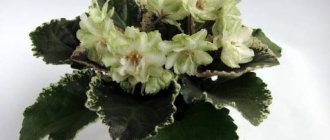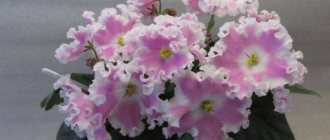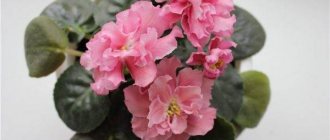An important place in indoor floriculture dedicated to varieties and hybrids of Uzambara violets. Flower growers all over the world love this exotic plant for:
- Charming appearance;
- A huge number of varieties;
- And also - an unpretentious character in terms of content.
To maintain a consistently beautiful decorative effect and create the prerequisites for long, lush flowering, it is enough to :
- Follow simple rules for caring for violets;
- And listen to the advice of experienced Saintpaulia lovers.
If these conditions are met, violets will feel comfortable even in the collections of beginners.
Below in the article you will see a photo and description of the Shanson violet, and also learn everything about caring for it.
Violet Chanson
Beautiful violet Chanson.
Among the original varieties of Saintpaulia, which enjoy constant success among flower growers with various years of experience and experience and often take prizes at various exhibitions, can be called the violet variety “Chanson” with fantasy flowering. Above is a picture of Saintpaulia Chanson.
History of the variety
INTERESTING! Authorship is often attributed to Paul Sorano, a famous plant breeder from the United States, or to employees of his plant breeding enterprise Lyndon Lyon Greenhouses. But on the Sorano website there is no mention of the variety of this magnificent violet.
If the taxonomic position of the Chanson violet variety is determined absolutely precisely and is not subject to any movements in the near future, then it is difficult to reliably name the breeder who grew this variety .
According to some unconfirmed reports, the Chanson violet is the result of domestic selection , however, the specific name of the grower who received this variety is not mentioned anywhere.
Officially, the author of the Saintpaulia variety “Chanson” is considered unknown , and violet catalogs indicate that the breeder is unknown.
Taxonomy
Violet Chanson is a fantasy variety from the genus Saintpaulia hybrida, representing the Gesnerieceae family:
- Based on the size of the rosette, the variety can be classified as an enlarged standard;
- And the shape of the corolla is of the “Bell” type.
Photo and description of the variety
This variety belongs to the standard species.
The original variety with a fantasy type of color forms a compact, standard-type rosette with a very neat outline . Typically, the size of the bush follows the minimum or average size of the standard (about 20 - 30 cm), but when creating ideal conditions for the plant, the rosette can become as large as possible for its type - up to 40 cm.
Violet leaves have a dark green tone with a slight tint of olive color, which:
- Does not always suit flower growers and collectors;
- And this is the only significant drawback of the variety.
From below, the leaves gradually acquire a reddish tint .
The leaf plates have a rounded configuration with a clear venation relief and sit on dense, elongated petioles. The glossy nature of the upper side of the leaves gives them a solemn, elegant look, and the reverse surface is covered with light, fluffy fibers.
ATTENTION! The leaf blades of the Chanson violet variety can be too fragile due to their juicy structure. This should be taken into account when placing the plant on the windowsill.
The flowering of the Chanson variety is of the cap type . Violet corollas are different:
- Particularly large sizes (more than 6 cm);
- And with an increased degree of terry, the edges of each petal have a slightly wavy configuration.
The velvety structure of the flowers is emphasized by sparkling inclusions .
The color tone of the buds varies from a bluish-lilac tint to a thick violet tone with a purple tint. The fantasy of the variety of peas, splashes and specks of various tones of pink on the entire surface of the flower
Peculiarities
Unlike many varieties and hybrids, violet :
- Blooms quite early;
- And it immediately produces abundant buds.
The duration of each flowering is approximately 3 months .
The peculiarities of the variety include the manifestation of its fantasy type only during the second flowering - the corollas of the first stage may not have a pink backlight. The violet gains full strength and beauty during the third blossoming of the buds.
Saintpaulia blooms for about 3 months.
Saintpaulia Chanson is different:
- Rapid growth;
- Formation of green mass;
- Rapid flowering from an early age;
- And the decorative splendor of a blooming rosette.
Violet is a very light-loving plant - with a small amount of daylight, it begins to pull the leaf blades upward, which disrupts its varietal decorative effect.
general description
The plant is classified as a variety that has a fancy coloring. The size of the violet is a standard bush. The plant has a very impressive appearance. The flowers are surrounded on all sides by leaves - the violet looks like a bright boutonniere.
During the first flowering, there may be no pink peas on the petals. Subsequent flowering of the plant confirms the characteristics of this species.
Attention! This variety has a high sensitivity to light - in the dark season it is necessary to provide it with full illumination, otherwise the violet will stop growing and developing, and may even die.
Care in indoor culture
Specimens of Saintpaulia Chanson can be considered an ideal option for the first acquisitions in the collection of novice flower growers. The plant is particularly unpretentious, so it will develop and bloom well with minimal care.
Conditions of detention
The special attitude of representatives of the variety to the illumination of the room predetermines the choice of place for keeping them in indoor culture .
Chanson violets are very light-loving, but do not tolerate direct sunlight on the buds and leaf blades.
Therefore, the most comfortable place for them will be on the windowsills of the western or eastern side of the house , where a balance is created between the amount and intensity of sunlight.
Here it will be possible to preserve the decorative appearance of the violet bush, so with sufficient lighting it will not pull out the petioles of the leaves, and to avoid sunburn.
Placing violets on the north side will require additional lighting with fluorescent spectrum lamps, and when the plants are located on the south windowsill, shading from the hot rays of the summer sun is required.
Tips for proper watering
The Chanson violet watering regime provides for regular moistening of the soil after a slight drying of its top layer - watering frequency:
- Depends on external factors;
- And it is determined based on visual observation of the plant.
Wick irrigation works well for this variety.
For specimens of this variety, twice a week is usually sufficient .
use different watering methods :
- Top watering under the roots with a teapot or a pharmaceutical pear prevents moisture from getting on the leaves;
- Watering through a pan prevents the substrate from acidifying, but requires regular drainage of excess water;
- Wick watering is ideal for long absences of the grower.
Any watering method should be used in conjunction with the organization of good drainage in the flowerpot.
Fertilizing rules
The small volume of soil in the flowerpot and the frequent flowering of violets require additional nutrition for the plant . Fertilizing can be done every month, it is better to apply them:
- In liquid form;
- Or after spilling the substrate.
It is necessary to regulate the content of various elements in the fertilizer depending on the life cycle of the specimen:
- As violets grow, it is necessary to increase the amount of nitrogen;
- During the flowering phase, reduce nitrogen to a minimum, add a percentage of phosphorus and potassium.
This will maintain health and guarantee lush flowering .
Light level control
The main feature of the Saintpaulia variety Chanson is its strong sensitivity to room lighting . Violet reacts positively to long daylight hours and does not like to be in the shade - it slows down growth and can delay flowering dates.
IMPORTANT! Specimens of the Chanson violet may die when placed on northern window sills without additional lighting in winter.
Violet prefers good lighting.
To form an ideal contour of the rosette, it is recommended to regularly rotate the pot with the plant a few degrees from its previous position relative to the light from the window.
Temperature and humidity
To create comfortable growing conditions, violets require maintaining temperatures within +20 + 24°C . In winter, a slight decrease in thermometer readings is allowed - by 2 - 3 degrees. A slight drop in temperature during flowering can extend the life of flowers.
Maintaining the temperature regime requires constant ventilation, which the violet loves very much.
The main thing is to protect the plant from hypothermia and strong movements of air currents, since drafts threaten the violet with severe troubles.
The humidity of an ordinary apartment is somewhat too low for Saintpaulias . You can increase it using:
- Humidifiers;
- Or by regularly spraying around the plant.
Soil requirements
The health and decorativeness of violets directly depends on the quality and nutritional properties of the substrate . For planting, soil rich in various elements is used, but at the same time light, permeable soil with good aeration. Drainage materials and activated carbon can be mixed into the substrate.
ADVICE! The quality of the soil will be preserved longer with a well-thought-out drainage system in the flowerpot.
Soil for Saintpaulias can be bought at a flower shop.
Pruning and hygiene
To provide all violet leaves with a sufficient amount of light, maintain the decorative contour of the rosette and carry out hygienic cleaning in order to protect against rotting, the plant is periodically pruned .
The procedure is to remove :
- Sick and damaged leaf blades;
- Dried corollas and peduncles;
- As well as extra shoots and healthy leaves that thicken the rosette.
Reproduction methods
To obtain young plants in indoor culture conditions, flower growers use several propagation methods :
- Seeds are a rather complex and lengthy process used to breed new varieties. Not suitable for propagation of hybrid violet Chanson, as it does not retain varietal characteristics;
- Leaf cuttings are the most common method: the leaf is rooted in a substrate or in water and then planted in a flowerpot;
- Stepchildren - a simple method, but it depends on the ability of a particular violet specimen to form layering.
Rules for transplantation and rejuvenation
Specimens of the Chanson variety do not tolerate transplantation very well , so such intervention should be carried out only if absolutely necessary. Before the transplant procedure, the following preparations should be carried out:
- Choosing a new flowerpot - a plastic pot should not exceed a third of the diameter of the rosette in volume;
- Arrangement of drainage in the vessel will protect against root rotting;
- Substrate preparation - it is better to use ready-made from the store to avoid infection with diseases or pests.
It is better to replant violets as needed.
CAREFULLY! When choosing between replanting or transshipment, you should pay attention to the fact that replanting with a change of soil allows you to notice damage to the roots of the plant in time, and transshipment is the safest method for the root system. The use of one method or another depends on the reason for transplanting the violet.
At 4–5 years of growth, violets show the first signs of aging . At this age, you can already resort to the rejuvenation method:
- Cut off the upper part of the bush with healthy and young leaves;
- Clean the stem;
- And they send it for rooting according to standard rules.
Differences in planting and growing from other varieties
Chanson, unlike other types of violets, does not like transplanting at all. You can use the transshipment method, but it needs to be done once every 2-3 years, trying to maintain the integrity of the earthen coma. Flowering plants cannot be handled or replanted - you need to wait until they bloom. It is worth replanting in winter, because violets bloom most abundantly in spring and summer.
It is also worth noting that watering this variety should be done no more than 2 times a week, while others require more frequent moistening. This is due to the fact that between waterings the earthen ball should dry thoroughly - this way you can avoid rotting of the roots.
Features of flowering, growth and reproduction
In general, the life cycles of Saintpaulia Chanson occur according to the same laws as other varieties and hybrids of Uzambara violets. Only minor differences can be noted in some areas.
Development in indoor culture
Violet Chanson is suitable for growing:
- As in the collections of experienced flower growers;
- So as a first experience for beginning Saintpaulia lovers.
Variety of violets presented:
- Does not impose special requirements on conditions of detention;
- Can easily adapt to the microclimate of a certain room;
- Grows quite quickly;
- It blooms early and very abundantly.
A wonderful gift for true violet growers.
To maintain the decorative appearance and preserve the health of the Chanson violet, it is enough to carefully and strictly follow all care regimens, listening to the advice of experts in this field.
How long does it take to grow an adult specimen?
When rooting a violet from a leaf cutting, it will take about two months . Next, Saintpaulia Chanson must go through the processes of developing a rosette and increasing the leaf mass.
The variety grows in 2 months.
The variety will have about eight months to do this, after which the plant will be able to form the first buds. This means that the young bush gradually becomes an adult violet - if rooting begins in early spring, by the end of winter you can get the first flowering.
The method of rooting a stepson will allow you to grow a young adult bush in a shorter period of time , since the baby is already formed by the time it separates from the mother plant. It will only take her time to grow.
Features of reproduction
Growing young specimens of Chanson violets follows the same rules as all other varieties of Saintpaulia. The plant can be propagated in three ways. Two of them are constantly used by gardeners - these are:
- Rooting a leaf;
- Or the separation of the stepson from the mother plant.
The methods are easy to implement and do not require much time and effort. It is enough to root a leaf or stepson using a mini greenhouse, and then plant the resulting seedling in a place of permanent growth. The main thing is to be careful.
The third method, propagation by seeds , presents great difficulties when used in indoor culture. The seed method is mainly used by breeders to obtain new varieties.
ATTENTION! The seed method is not suitable for propagating hybrid varieties of Saintpaulia, including Chanson violets - the characteristics of the parent forms are not preserved in the offspring. To preserve varietal properties in this case, the rejuvenation method should be used.
Specifics of flowering
The presented Saintpaulia blooms very early.
Violet Chanson can produce its first flowering very early - in the eighth month of life. In this case, the formation of buds occurs rapidly, and a large number of flower stalks are formed. The duration of this wonderful process is about 3 months.
A varietal feature of flowering is the appearance of pink splashes only during the second and sometimes third flowering. The very first buds open in one color. All characteristics of the variety intensify as the number of flowering increases.
Appearance of peduncles
From the first formation of buds, the Chanson variety produces a large number of peduncles . By their nature they are:
- Sturdy;
- Elastic;
- And thick enough to withstand the significant weight of flowers (up to 6 pieces on each of them).
But the violet peduncles of this variety have an interesting feature - they can change their structure during subsequent flowerings . Peduncles can be either erect or tucked onto leaf blades, while firmly bearing all the formed corollas.
Flowering type
Due to the formation of a large number of peduncles, each bearing up to 6 large, double flowers, a neat and lush cap of purple color with a pink glow on the petals is formed above the leaf rosette of the Chanson violet. According to its characteristics, the variety can be classified as violets with cap flowering.
The variety has cap flowering.
Flowering duration
When creating optimal conditions for the flowering phase, the Chanson variety can retain a flowering cap for up to 3 months . Each flower individually can bloom for about a month under comfortable conditions.
How to care for violets at home - instructions for beginners
A blooming violet captivates at first sight with its tenderness and beauty of flowering.
Despite its low demands, homemade violets need care that is close to natural growing conditions.
Abundance of light and not a drop of sun
Violets love diffused light and cannot stand direct sun, which burns their delicate foliage. Before learning how to care for violets, it is worth studying the optimal conditions for the location of the flowerpot, which determines not only the growth of the plant, but also the intensity of flowering.
The African beauty herself tells whether there is enough light for her to feel great. If there is insufficient quantity, the leaves of the plant stretch upward, and if there is excess, they fall down.
For abundant long-term flowering, it is necessary to provide it with up to 10-12 hours of light. The solution to this problem can be artificial lighting - fluorescent lamps with a power of 36-40 W. If you have your own collection, it is advisable to think about creating a special rack for placing plants.
Half of caring for violets is providing the plants with enough light:
- Varieties with light green leaves develop well in low light.
- Individuals with dark, rich foliage are very demanding of light output.
Neither hot nor cold
Caring for blooming violets also consists of organizing the temperature regime - the optimal indicators are 20-25 degrees. Fantasy varieties are best kept at 17-20 degrees, since higher temperatures lead to a loss of border brightness and fantasy expressiveness.
Household appliances - a fan, air conditioner, humidifier, window - will help create an optimal temperature regime without significant changes.
New house
The pot with the soil mixture must match the requirements of the plant. The result is beautiful violets that delight with abundant flowering in the first year.
The plant needs:
- Small containers, up to 15 cm in diameter;
- Light soil mixtures;
- The presence of drainage holes for drainage/suction of water.
Water for a lady
Home care involves organizing regular watering - the water should sit for 2-3 days and have a temperature higher than the temperature in the room. It is recommended to use boiled water, free of salts and impurities.
For the African miracle to thrive, the humidity should be about 50%. In a city apartment, such figures can only be achieved with the help of a modern humidifier.
Balanced diet
The plant especially needs a balance of minerals and trace elements. The choice of ready-made fertilizer should be made depending on the time of year.
Feeding according to the seasons:
- Spring – 2-3 times a month;
- Summer – 4-6 times for 30 days;
- Autumn – 1-2 times a month;
- Winter is a dream.
In a specialized store you can purchase ready-made preparations for plant nutrition.
There are also folk methods for fertilizing violets from professionals: black tea, coffee grounds, citrus peels, yeast, sugar. They should be used carefully and competently.
Violets, which are properly cared for, delight with healthy foliage, beautiful appearance and flowering for several months.
Reviews
Tatyana Vasilievna. “I hasten to share my great joy - I finally saw the true blossoming of my Chanson. The first two blooms were very inconspicuous. Although there were many flower stalks, I was not impressed by the flowers. Instead of a magnificent pink pattern against the background of purple petals, I observed simply dark blue buds, which, both in size and plumpness, did not in any way resemble the varietal Chanson.
And now - the third flowering. I have a huge, wildly double flower opening, which simply glows from the pink splashes. Such beauty! It’s not in vain that I waited!”
Nicole. “I read that the Chanson violet is distinguished by foliage with an olive tint of greenery. This color of the leaves is also clearly visible in all the photos. I was given a flower of this variety for my birthday. All signs match the description:
- And big flowers;
- And terry;
- And the coloring is like that of a fairytale bird.
The leaves grow evenly in a circle, shiny on top, fluffy below. But no olive color. Maybe this is not Chanson?
Florists are attracted by the fabulous color of violets.
Anyuta. “My grandmother bought me my first violet and said that her name was Chanson. I really liked her. I put it on the nightstand next to my crib so that I could be close to it when I sleep. But then my Chanson stopped producing leaves, everything drooped and began to dry out. But I watered it correctly. I called my grandmother and complained. And she scolded me and ordered the Chanson to immediately put on the windowsill. At first I was offended and cried. But then I realized that my violet should live on a window where there is a lot of light. Now it’s blooming, and I’m painting it.”
Story
Even in Ancient Greece, the Greeks considered this flower a symbol of sadness and death - most often they used it to decorate the graves of young girls. But, in our modern society, this flower is considered a symbol of the awakening of nature. And oddly enough, it has its own special history.
According to ancient Greek myth, it can be considered that the daughter of Titan, when she was fleeing from Apollo, asked Zeus for help. He, in turn, turned the girl into a beautiful flower, which over time began to be called a violet. After the magical transformation, Zeus hid the flower deep in the forest.
And no one would have noticed her if the violet had not been stolen by Hades, the king of the government of the dead. But suddenly he got scared and dropped the flowers on the ground. They, in turn, began to actively grow and delight everyone around them with their beauty.
The Greeks consider the violet to be one of their favorite flowers. This symbol of Athens appeared back in the days of Ancient Greece. With the help of violets, artists depicted the images of women.
Disease and pest control
If all care regimens are followed, Saintpaulias rarely get sick or are attacked by pests . Only a plant weakened by maintenance errors can be afraid of various pathogens and parasites.
The most dangerous for violets are :
- Gray rot;
- Fusoriosis;
- Powdery mildew;
- And late blight.
At the first signs of disease, the plant must:
- Send to quarantine;
- Transplant;
- Having eliminated all affected areas;
- And treat with fungicides.
If not properly cared for, violets may become pests.
The main pests of Saintpaulia include:
- Cyclamen and spider mites;
- Scale insects;
- Nematodes;
- Aphid.
Control measures:
- Quarantine;
- Removing damaged parts;
- And treatment with insecticides and acaricides.
Appearance
The leaves of this plant are large, they have a dark green, uniform color. They are characterized by a rounded shape with high legs. On the reverse side the leaves are drooping, and on the front side they are often smooth, with a slight shine. They are juicy and weightless, very neatly assembled into a rosette. Their shade looks good with flowers.
The flowers of this variety are double to the touch, have a dark blue color , and they are collected in rosettes in the amount of 5-6 pieces. The edges of the petals are wavy or scalloped. Peas are densely scattered on them, reminiscent of sunbeams in appearance. The petals are velvety and have shiny sparkles. Flowering is often abundant and frequent.
Other varieties of violets with the word Chanson
Violet EK-Russian Chanson
Bright blue violet EK-Russian Chanson.
Variety by breeder E.V. Korshunova. Introduced to a wide range of flower growers in 2014.
A distinctive feature is variegation . The leaf plates are painted in a dark green color, along the edges there is a lilac border with a flesh-colored tint to a greater or lesser extent. The reverse side has a reddish tint.
The leaf itself is wavy, with rounded notches. The flowers are like those of the Chanson variety: large, double structure, with a delicate pink glow. The difference is in color : Russian Chanson has sapphire-tone rims.
Violet NS-Ukrainian Chanson
Mysterious Saintpaulia NS-Ukrainian Chanson.
Variety of breeding work by S. Novoseltseva .
A distinctive feature is the magnificent beet color with a purple tint of the corollas with extremely small dots of pink glow. Flowers with a high degree of terry, highly layered arrangement. Sheet plates:
- Dark shade of green;
- With a reddish reverse;
- With a smooth and shiny surface.
Violet L-Odessky Chanson
Mysterious violet L-Odessa Chanson.
The variety belongs to the selection of T. Lutskaya .
A distinctive feature is the not very strong terry of the corollas with significant fringe of the petals. Large flowers surprise with a plum shade of purple. Against this background, spots and specks of a yellowish lunar color stand out brightly. The leaf blades are dark green with a reddish tint on the reverse side and have a wavy fringe along the edges.
Conditions of detention
Lighting
Sunlight plays a big role in caring for violets. Daylight hours should be at least 10 hours. For this purpose, in winter, additional lighting with artificial lamps is used.
Direct sunlight is detrimental to leaves, so only diffused light is suitable. Windows facing south-east and south-west are ideal. It is recommended to shade south-facing windows.
To ensure that the rosette forms beautifully and evenly, the flower is rotated 45° every 3 days.
Temperature and humidity
Watering
When watering, use a watering can with a long spout, preventing moisture from getting on the leaves.
Many gardeners moisten the soil through a tray. Leaving the flower pots in a tray with water for a few minutes, then drain the remaining water. To avoid the process of rotting of the root system due to dampness.
Watering is carried out with settled water after the soil has completely dried.
On a note!
If flowers need to be left without an owner for some time, automatic watering is organized. To do this, lower the end of a thick rope into a bucket of water, and place the other end in a pot.
Fertilizer
Receiving regular feeding, violets retain their abundant flowering for a long time. Apply special fertilizer for Saintpaulias, according to the instructions, once a month.
To prolong flowering, fertilizers with phosphorus and potassium are used. And during the formation of the rosette, nitrogen complexes.
Transplant and pot
For the “Chanson” variety, the soil is changed 2 times a year, using the transshipment method.
Watering is carried out 2 days after the procedure.
For a superficial violet root system, a wide, but not deep, pot is suitable.
The diameter of the Saintpaulia pot is 3 times less than the diameter of the rosette. As the plant grows, the capacity is increased. For an adult plant, the maximum diameter is 10-12 cm.
Reproduction
Violets reproduce in several ways:
- Seeds are the most labor-intensive process; most often it is used by breeders to breed new hybrid varieties.
- Leaf cuttings - the cutting is cut from the rosette from the second row. Root either in water or directly in the ground. After the roots appear 0.5-0.6 mm. the plant can be transplanted into a pot with soil mixture. Approximately 45-60 days from the cutting, young roots are formed.
- Stepping is the most effective and simplest method of propagation. During the growing season, the flower forms many stepchildren. They are found in the axils of the lower leaves.
Using a sharp object or tweezers, remove the rosette and plant it in a container with drainage and loose soil. Cover the top with a transparent film or cap. Remove the greenhouse after the rooted rosette begins to produce new shoots. The cuttings are ready for transplantation after the new leaves have grown by 4-5 cm.
Possible diseases
Like any plant, violet can also get sick. For such a plant, the greatest danger is posed by infectious diseases, namely: pathogens - viruses, fungi and bacteria, and pests:
- spider mite;
- scale insect;
- nematodes and aphids.
The best thing is to prevent the violet from starting to hurt. Therefore, the most competent solution is the prevention of all diseases by spraying with special preparations.
Violet is a plant of amazing beauty that should be in every home. It is quite easy to maintain and therefore suitable for beginners. If there is a desire to propagate the plant, it will not take much effort and effort. And if you successfully complete this task, even more representatives of such a beautiful flower as the violet will appear in your home.
If you find an error, please select a piece of text and press Ctrl+Enter.
{SOURCE}
Dangerous diseases
Violet is a delicate flower that has low resistance to viral, fungal and infectious diseases. These problems appear on weak plants, the care of which does not comply with established rules.
High humidity levels and low ambient temperatures can lead to a number of diseases.
- Bacteriosis is a disease that can occur during the warm season. Signs are the presence of dark spots, darkening of the underside of the foliage, wilting of flowers and changes in the structure of the leaf blade. Methods of control: destruction of the plant.
- Powdery mildew is a fungal disease that can lead to plant death. Signs are the presence of a white coating on the surface of the leaves, which provokes the appearance of ulcers and roughness of the leaves. The causes are infection from soil, garden tools and diseased plants. Treatment is to remove infected leaves and treat the plant with special fungicides.
- Rust is a dangerous type of fungal disease that must be treated at the first sign of its appearance. Signs are the presence of brown spots on the surface of the leaf and yellow capsules with spores on the underside. Reasons: low light levels, weak immunity, plant infection. Treatment - removal of diseased leaf blades, isolation of the plant, treatment of the bush with fungicides.
- Root rot is a disease of the root system that prevents the formation of flowers. Signs: prolonged absence of peduncles, lethargy of leaves and petioles. Reasons: lack of drainage layer, poor quality of soil mixture, excessive watering, low soil temperature. Treatment is to remove damaged parts or completely destroy the plant, treat it with a fungicide and change the pot and soil.
When the first signs of the disease occur, a set of measures must be taken:
- removal of damaged parts of the plant;
- treating the flower with special chemicals;
- replacement of nutrient soil and flower pot.
It is strictly forbidden to fertilize the plant earlier than 30 days after its recovery. A weakened flower is not able to absorb nutrients, an excess of which can cause the death of the plant.
The following pests can harm the plant:
- spider mite;
- cyclamen mite;
- nematode;
- aphid;
- scale insects;
- fungus gnats.
When pests appear, the plant must be treated with special insecticides.
Beginning flower growers may encounter a number of other problems:
- wilting and drying of leaves;
- staining;
- rotting of the root system.
Causes of yellow and brown spots:
- sunburn;
- low or high air humidity;
- unbalanced watering with cold water;
- excessive application of nitrogenous fertilizers.
To learn how to properly water a violet, watch the video below.
Priming
The soil substrate is prepared from peat, leaf soil and sand in a ratio of 3:5:1. All ingredients are thoroughly mixed. You can add charcoal and/or sphagnum moss. Expanded clay or vermiculite can be added to the soil. A prerequisite for growing violets is the presence of drainage.
Pot
The characteristics of the root system of violets determine the choice of pot for the plant.
It is better to choose shallow, flat pots - they are more suitable for a superficial root system.
The size and age of the plant must be taken into account. For mini-varieties and children violets, take the smallest pots - up to 6-8 cm in diameter. As the plant grows, every 2-3 years it is transferred to pots of larger diameter.
When choosing a flower pot, you should always adhere to the 3:1 rule - the diameter of the pot should be three times less than the diameter of the plant.
The material for the flower pot can be any - plastic or ceramic.
Lighting
The “Chanson” violet does not like direct sunlight. Leaves react to excess sunlight by appearing whitish spots and burns on them.
Plants live well on western and eastern windows, but on northern windows they lack light.
In autumn and winter, violets need additional lighting. With a lack of light, flowering is delayed and plant growth stops.
Important! In order for the plant to be evenly illuminated and develop properly, every 3-4 days the pot must be turned to the light with the other side.
Temperature
In winter, the room temperature should not fall below 18 degrees. Comfortable temperature for Saintpaulias is 22/25 degrees. Violets are afraid of drafts. The room must be ventilated regularly.
Humidity
For growth and flowering, this variety requires a humidity of 50% to 70%.
You cannot spray this plant - it may die. Experienced gardeners advise placing containers of water next to the plant. The second method: pour expanded clay into pallets and always make sure it is wet.
Check out other varieties of violets on our website: “Blue Fog”, “Cinderella’s Dream”, “Esmeralda”, “Lituanica”, “Ice Rose”, “Olesya”, “Summer Twilight”, “Jan Minuet”, etc.











